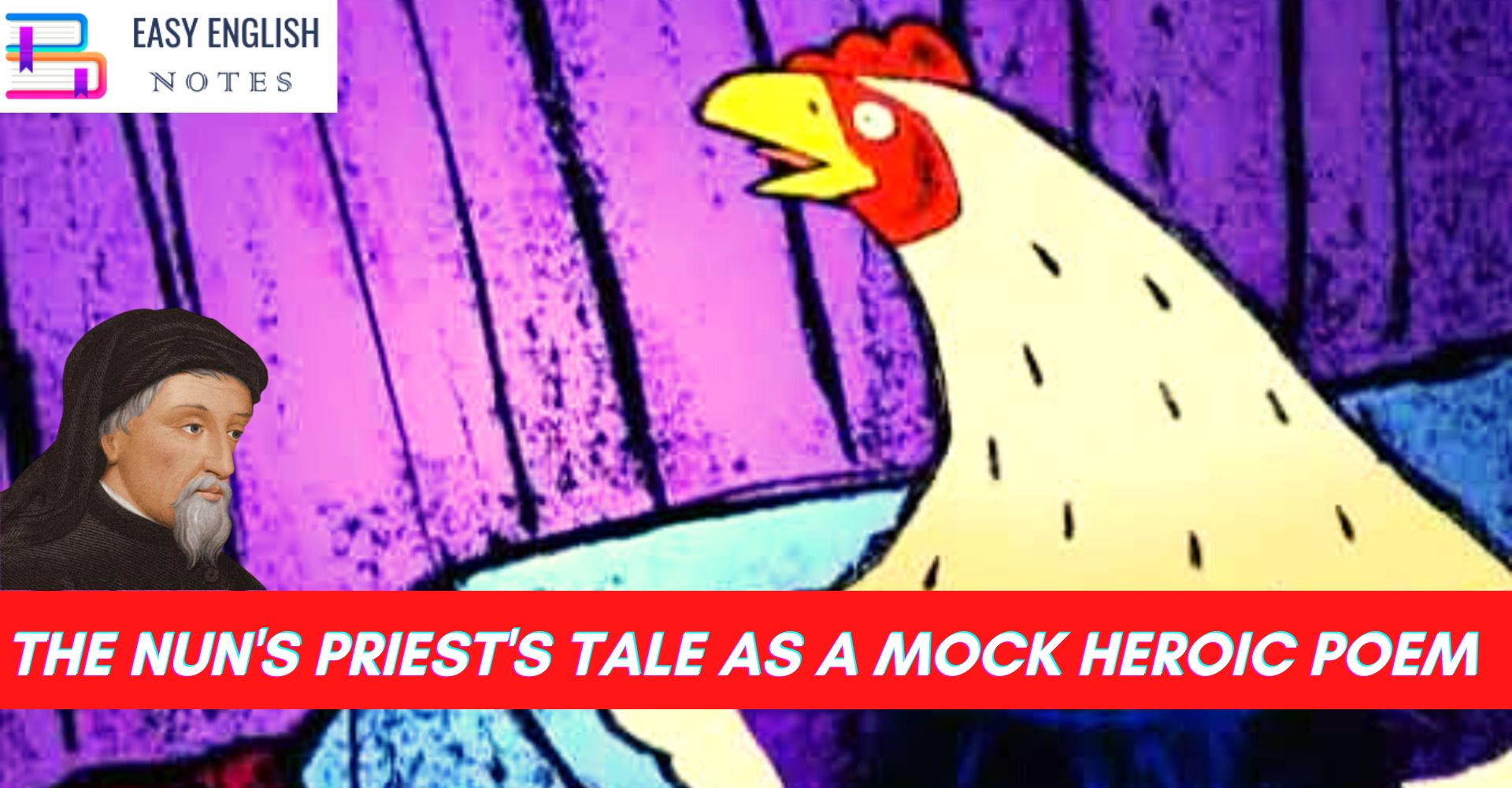A heroic poem is an epic poem. It tells the story of a hero whose adventures and exploits have a great recognised significance. It is a long narrative poem written in an elevated style. Homer’s Iliad and Odyssey and Milton‘s Paradise Lost and Paradise Regained are the well-known heroic poems.
A mock-heroic poem is one in which the subject is mean or low or trivial, but the method or manner or style of it is clavated or high or grand. Some of the famous mock-heroic poems in English Literature are Samuel Butler’s Hudibras, Alexander Pope‘s The Rape of the Lock, Gray’s Ode on the Death of a Favourite Cat and Fielding‘s Tom Jones. The subject-matter of The Nun’s Priest’s Tale is trivial: it is the carrying off by a fox of a cock and the cock’s escape from the fox’s clutches. But Chaucer treats this animal story as if it were the tale of some mighty hero facing a disaster, and the means of achieving this is a grand, elegant style, such as a genuinely heroic poem would employ. The language used. the descriptions and dialogue, the similes and lofty exclamations, are sustained at this exalted level throughout the poem. But we never lose sight of the joke. for at intervals the narrator reminds us of the farmyard and the triviality of the subject, so that we recognise the grand style as having a mock-serious motive.
The description of Chanticleer, the cock is in the heroic style. In all that land. no one was Chanticleer’s equal at crowing, his voice was merrier than the church-organ 011 feast days: his crowing was more reliable than the abbey-clock: he knew by instinct the beginning of each equinox: his comb was redder than fine coral, and bastilles like a castle-wall: his black bill shone like jet; his legs and his toes were like burnished gold. But all these high-sounding phrases are used for mere cock. Here lies the mock element besides the dialogue of the poem. There is a joke in almost every line of Chanticleer’s long speech.
The narrator (the Priest) heightens the mock-heroic element of his story by a comic use of lofty similes. True heroic poetry acquires much of its grandeur and stateliness from its use of metaphorical language. But in mock-heroic poetry, such language becomes comic because of its use in relation to the pettiness of the subject. There are several examples of this in The Nun’s Priest’s Tale, from the initial comparison of Chanticleer’s voice to a Courch-organ to the final suggestion that even the murderous mob which swept through the streets of London at the time of the Peasant’s Revolt in 1381 under the leadership of Jack Straw, was not half as terrifying as the pursuit of the fleeing fox. The more daring the comparison, the more mock-heroic it becomes in a low context. A fox may certainly be called a “homicide”, but to call him a new “Judas Iscariot” and compare him with other notorious traitors in human history is surely to touch the heights of extravagance. The terrified hens produce a loud clamour as they see their lord and master being carried off. Neither the fall of Troy nor the conquest of Carthage, nor Nero’s burning of Rome caused such laments clucking in their yard, are compared to wives and mothers suffering some of the most tragic moments in history. The careful balancing of key words and phrases helps to achieve the right effect. The agony of innocent suffering is transferred, by way of the slain Roman senators’ wives, to the hens. The barn-yard becomes inflated until it can stand comparison with Rome. This kind of inflation or false aggrandisement, is the secret of the mock-heroic technique.
Also Read :
- Chaucer’s narrative art in “The Nun’s Priest’s Tale”
- “The Pardoner’s Tale” is the finest tale of Chaucer
- Prologue to Canterbury Tales – (Short Ques & Ans)
Chaucer deserved this praise, and just as only the most accomplished acrobat can clown drunk on a tightrope, so only a rhetorician as accomplished as Chaucer had the skill to clown rhetoric as it is clowned in the mock-heroic manner of The Nun’s Priest’s Tale.
Parody at this high level of performance is not the blatant decision that sometimes passes for parody; it is the light, affectionate raillery of a style he had long since mastered and which he could afford to make fun with. Although he had learnt so much from them. Chaucer could not but feel there was something to laugh at too in the pedantries of the rhetoricians.
In the description of Chanticleer. for instance, Chaucer is exactly, preposterously. following the rules laid down for describing a beautiful girl, in a solemnly rhetorical work called Poetria Nova. written in the first half of the thirteenth century (a hundred years before Chaucer was born) by a teacher of rhetoric called Gaufred de Vinsauf. Chaucer knew his work well and indeed much of his best and most serious poetry reflects the rules of the Xlova Poetria. It is to this teacher that Chaucer pays ironical tribute in The Nun’s Priest’s Tale. When he bursts out with the exclamation.
O Gaufred. Deere maister soverayn! Towards the end of the poem.
Gaufred’s rule for describing a beautiful girl was simple: start at the top of her head and go down. Detail by detail to her feet….Let the splendour (of her description) descend from the top of the head to the very root and let all, at he same time, be published to the toe-nail.
To these precepts in picturing chanticleer, Chaucer has been solemnly grotesquely obedient, not forgetting the toe-nail.
PLEASE HELP ME TO REACH 1000 SUBSCRIBER ON MY COOKING YT CHANNEL (CLICK HERE)











